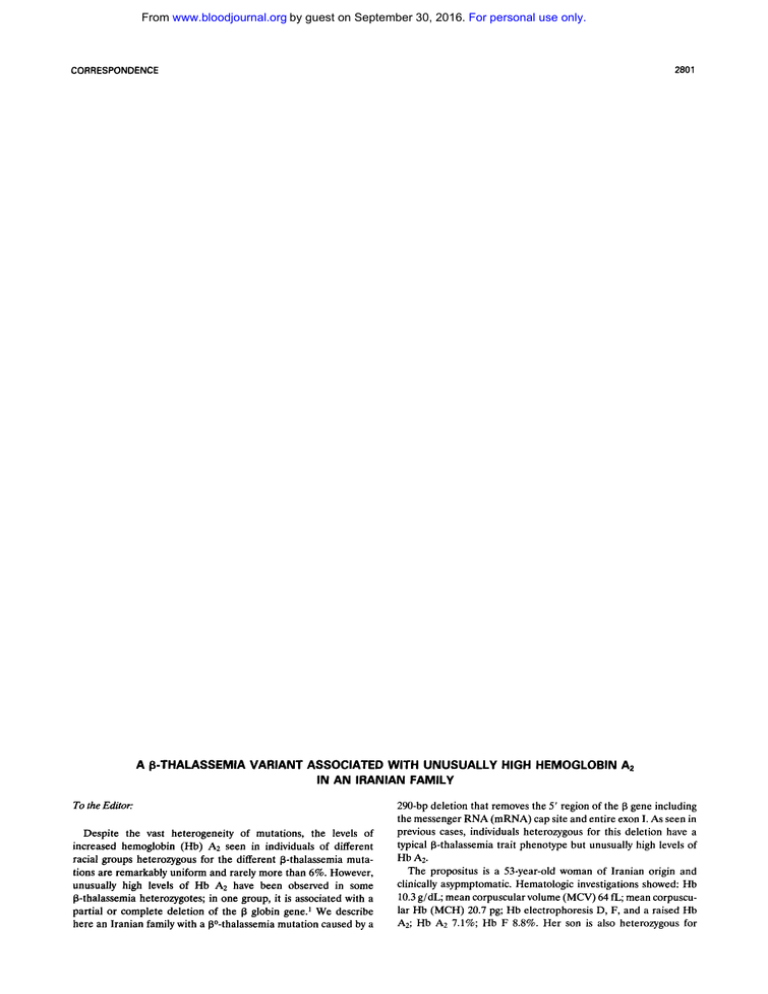
From www.bloodjournal.org by guest on September 30, 2016. For personal use only.
280 1
CORRESPONDENCE
A p-THALASSEMIA VARIANT ASSOCIATED WITH UNUSUALLY HIGH HEMOGLOBIN A2
IN AN IRANIAN FAMILY
To the Editor:
Despite the vast heterogeneity of mutations, the levels of
increased hemoglobin (Hb) A2 seen in individuals of different
racial groups heterozygous for the different P-thalassemia mutations are remarkably uniform and rarely more than 6%. However,
unusually high levels of Hb A2 have been observed in some
P-thalassemia heterozygotes; in one group, it is associated with a
partial or complete deletion of the P globin gene.' We describe
here an Iranian family with a Po-thalassemia mutation caused by a
290-bp deletion that removes the 5' region of the p gene including
the messenger RNA (mRNA) cap site and entire exon I. As seen in
previous cases, individuals heterozygous for this deletion have a
typical P-thalassemia trait phenotype but unusually high levels of
Hb Az.
The propositus is a 53-year-old woman of Iranian origin and
clinically asypmptomatic. Hematologic investigations showed: Hb
10.3g/dL; mean corpuscular volume (MCV) 64 & mean corpuscular Hb (MCH) 20.7 pg; Hb electrophoresis D, F, and a raised Hb
A2; Hb A2 7.1%; Hb F 8.8%. Her son is also heterozygous for
From www.bloodjournal.org by guest on September 30, 2016. For personal use only.
2802
CORRESPONDENCE
Fig 1. Amplification of the 5' end of the p globin
gene by the PCR in the propositus (P) and a normal
individual. AP1 represents the forward primer, 5'TCCAGGCAGAAACAGlTAGATGTC-3'. and AP2 the
reverse primer, 5'-CAlTCGTCTGlTTCCCAlTCTA-3'
used in the first PCR. The second PCR used the
biotinylated primer, Bio-AP3 (5'-CGATClTCAATATGClTACCAAG-3'). and AP2. Lanes M1 and M2 represent the markers phi X Hae 111 and A Hindlll, respectively, BI, blank; P, patient; N, normal individual.
p-thalassemia with Hb 12.1 g/dL, MCV 66 E,MCH 21.2 pg, Hb Az
7.8%, and Hb F 6.5%. The unusually high Hb A2 level of the
propositus. who is a compound heterozygote for Hb D and
@-thalassemia, and her son is reminiscent of the hematologic
phenotype of individuals heterozygous for p-thalassemia mutations
due to deletions of the 5' region of the p gene.
The P globin complex in the propositus was analysed with a
series of restriction enzymes and Southern blot hybridization.
Digests of restriction enzymes (B&d11, A t I, Dra 1, a.:dAva 11) with
sites that flank the 5' end of the p gene and hybridization with a p
globin gene probe (Psr I p) show an abnormal band that is -300 bp
smaller than the expected normal (data not shown). The deletion
removes a site for Nco I in the initiation codon. The presence of the
deletion was confirmed by enzymatic amplification of this region of
the p globin gene by the polymerase chain reaction (PCR) using
primers that flank the deletion (Fig 1). In normal individuals, a
product of 1454 bp is obtained; in the propositus, an additional
band of 1,200 bp is seen. The endpoints of the deletion were
defined by direct sequencing of the abnormal PCR product using
the following approach. The PCR products were separated in 1.0%
low-melting point agarose (Bethesda Research Laboratories, Bethesda, MD). After staining with ethidium bromide, the smaller
fragment was localized and cut out under ultraviolet light. The
agarose containing the fragment was melted and an equal volume
of water added. Ten microliters of this product was subjected to
another 30 cycles of amplification under reaction conditions similar
to the initial PCR, with the exception of using a different set of
primers: one 5'4iotinylated and internal to the previous (BioAP3). and the other as previously described (Fig 1). Singlestranded DNA (ss DNA) one 5'-biotinylated and the other
complementary to the biotinylated-primed ssDNA, were prepared
as describedZ and sequenced by the dideoxy chain termination
method using Sequenase and the reagents as provided in the kit
(US Biochemicals Corp. Cleveland, OH). Five microliters of the
ssDNA and 1 pmol of the appropriate primer (internal or similar to
that used in the PCR) were used per sequencing reaction.
The breakpoints of the deletion were determined by comparing
the nucleotide sequence of the amplified DNA with that published
of normal p gene in the region of the deletion. The deletion is 290
bp in length; three breakpoints are possible due to the presence of
wo guanine nucleotides common to both ends. The 5' breakpoint
is 123 to 125 bp upstream of the cap site and the 3' end is at
nucleotide 23 through to 25 of IVS-I of the p globin gene (Fig 2).
The deletion endpoints as determined by sequencing the biotinylated single strand were consistent with those determined from
sequencing the complementary strand. Restriction analysis of
-
Fig 2. Breakpoint DNA sequences of the p-thalassema deletion.
The potential deletion breakpoints are indicated by the arrows and
are located 123 to 125 bp upstream of the cap site and at nucleotides
23 through to 25 of IVS-1 of the p globin gene, close to a GACAGGT
heptamer direct repeat (boxed). The inverted repeats are underlined.
From www.bloodjournal.org by guest on September 30, 2016. For personal use only.
2803
CORRESPONDENCE
DNA amplified by the PCR showed that the son has an identical
deletion.
We have characterized a po-thalassemia mutation due to a
290-bp deletion that removes the promoter region, the entire exon
I, and part of the IVS-I of the p gene. This deletion appears
identical to another recently described in a Jordanian3 and also in a
Turkish family4 and, in view of the close geographic proximity, it is
likely that these deletions are of a single origin. In both the Turkish
and the Iranian family in this report, individuals heterozygous for
the mutation have unusually high levels of Hb A2 (7.1% to 8.1%)
and variable increases of the Hb F, in keeping with previous
observations. Six deletions ranging in size from 290 bp to 12.6 kb
affecting only the p globin gene have been de~cribed.3.~
The 619-bp
deletion that accounts for 20% of the p-thalassemia in Asian
Indians removes the 3‘ end, leaving the 5’ end of the p gene intact,
whereas the others are rare, isolated events and remove the 5’ end
of the p gene leaving the 6 gene intact. Individuals heterozygous for
the 619-bp deletion have increases in Hb A2 levels that are
indistinguishable from the other common forms of p-thalassemia.
In contrast, heterozygotes for the other five deletions have exceptionally high levels of Hb Az. The region extending from position
-125 to +78 (relative to the mRNA cap site of the p gene) is
removed in each of the five deletions that are associated with the
variant of high Hb A2 P-thalassemia. This region includes the CAC
box, the CAAT box, and the TATA box of the p globin gene
promoter.
The mechanisms underlying the unusually high Hb A2 in these
heterozygous p-thalassemias are not completely clear. Family
studies of individuals heterozygous for p-thalassemia and a 6
variant have shown that the increased Hb A2 is derived from both 6
genes, the one in-cis as well as the one in-trans to the p-thalassemia
gene. Recently, study of an individual heterozygous for the 1.39-kb
deletion and a 6 chain variant’ showed that, in addition to an
increased HbA2 derived from both 6 genes, there is a disproportionate increase of A2 derived from the 6 gene in-cis. This would
support the proposal that removal of the 5’ p globin gene promoter
removes competition for the hypersensitive sites in the upstream
locus control region (LCR) such that the LCR could then interact
with either the 6 or y gene in-cis to enhance their expression.I0
Examination of the nucleotide sequences surrounding the endpoints of this 290-bp deletion shows a heptamer repeat (GACAGGT) at the breakpoints of the 5’ and 3‘ normal sequences (Fig
2) as well as the presence of an inverted repeat (CTGTC). The
deletion has removed one of the heptamers that supports the
proposed mechanism underlying the generation of such short
deletions, a model of ‘slipped mispairing’” that leads to the loss of
one repeat and all sequences between the direct repeats.
ACKNOWLEDGMENT
We thank Caroline Bastable for preparation of the manuscript.
SWEE LAY THEIN
REBECCA BARNETSON
MRC Molecular Hematology Unit
Institute of Molecular Medicine
oxford, UK
S A A D ABDALLA
Department of Hematology
St Mary’s Hospital Medical School
Imperial College of Science Technology and Medicine
London, UK
REFERENCES
1. Codrington JF, Li HW, Kutlar F, Gu L-H, Ramachandran M,
Huisman THJ: Observations on the levels of Hb A2 in patients with
different @-thalassemia mutations and a 6 chain variant. Blood
76:1246,1990
2. Thein SL, Hinton J: A simple and rapid method of direct
sequencing using Dynabeads. Br J Haematol79:113,1991
3. Spiegelberg R, Aulehla-Scholz C, Erlich H, Horst J: A
p-thalassemia gene caused by a 290-base pair deletion: Analysis by
direct sequencing of enzymatically amplified DNA. Blood 73:1695,
1989
4. Diaz-Chico JC, Yang KG, Kutlar A, Reese AL, Aksoy M,
Huisman THJ: An -300 bp deletion involving part of the 5’
P-globin gene region is observed in members of a Turkish family
with p-thalassemia. Blood 70583,1987
5. Waye JS, Cai S-P, Eng B, Clark C, Adams JG 111, Chui DHK,
Steinberg MH: High hemoglobin A2 Po-thalassemia due to a
532-basepair deletion of the 5’ @-globin gene region. Blood
77:1100,1991
6. Popovich BA, Rosenblatt DS, Kendall AG, Nishioka Y
Molecular characterization of an atypical P-thalassemia caused by
a large deletion in the 5’ P-globin gene region. Am J Hum Genet
39:797,1986
7. Gilman JB: The 12.6 kilobase deletion in a Dutch p”thalassemia. Br J Haematol76:369,1987
8. Thein SL, Hesketh C, Brown JM, Anstey AV, Weatherall DJ:
Molecular analysis of a high A2 p-thalassemia by direct sequence of
a single strand enriched amplified genomic DNA. Blood 73:924,
1989
9. Spritz
Orkin SH: Duplication followed by deletion
accounts for the structure of an Indian deletion Po-thalassemia
gene. Nucleic Acids Res 1093025, 1982
10. Hanscombe 0,Whyatt D, Fraser P, Yannoutsos N, Greaves
D, Dillon N, Grosveld F Importance of globin gene order for
correct developmental expression. Genes Dev 51387,1991
11. Efstratiadis A, Posakony JW, Maniatis T, Lawn RM,
O’Connell C, Spritz RA, DeRiel JK, Forget BG, Weissman SM,
Slightom JL, Blechl AE, Smithies 0, Baralle FE, Shoulders CC,
Proudfoot NJ: The structure and evolution of the human P-globin
gene family. Cell 21:653,1980
From www.bloodjournal.org by guest on September 30, 2016. For personal use only.
1992 79: 2801-2803
A beta-thalassemia variant associated with unusually high
hemoglobin A2 in an Iranian family [letter]
SL Thein, R Barnetson and S Abdalla
Updated information and services can be found at:
http://www.bloodjournal.org/content/79/10/2801.citation.full.html
Articles on similar topics can be found in the following Blood collections
Information about reproducing this article in parts or in its entirety may be found online at:
http://www.bloodjournal.org/site/misc/rights.xhtml#repub_requests
Information about ordering reprints may be found online at:
http://www.bloodjournal.org/site/misc/rights.xhtml#reprints
Information about subscriptions and ASH membership may be found online at:
http://www.bloodjournal.org/site/subscriptions/index.xhtml
Blood (print ISSN 0006-4971, online ISSN 1528-0020), is published weekly by the American
Society of Hematology, 2021 L St, NW, Suite 900, Washington DC 20036.
Copyright 2011 by The American Society of Hematology; all rights reserved.



